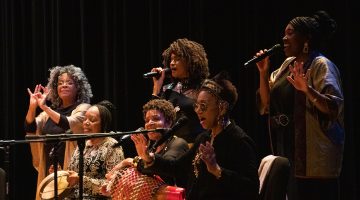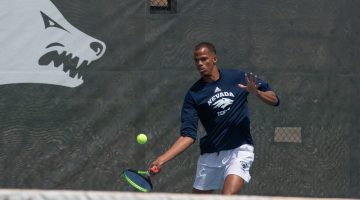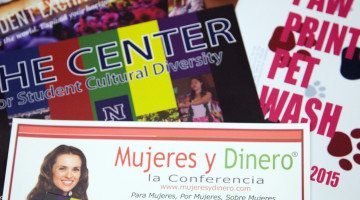
Breanna Denney/Nevada Sagebrush
Members of the Black Student Organization and other groups stand with University of Nevada, Reno, President Marc Johnson in support of protesters at the University of Missouri, Columbia, in the Quad on Thursday, Nov. 19. Johnson and other administrators are working towards unifying the students and faculty across different borders.
By Marcus Lavergne
Defining “diversity” at the University of Nevada, Reno, involves taking more than just race into account. With a multifaceted conglomerate of groups, cultures, organizations, and backgrounds forming both the university’s student and faculty populations, continuously diversifying the campus remains one of the foremost goals and intricate challenges for the administration.
At a glance, demographics have changed significantly over the past decade. The number of students that identify with a minority race or ethnicity at UNR has increased from around 2,600 in 2001 to more than 7,000 as of fall 2015 — nearly a 300 percent rise.
An increase in minority students is reason for the university to be optimistic about future student population growth. Since President Marc Johnson took office in 2012, his offices have worked toward not only continuing the growing trend, but also toward creating a tolerant, comfortable UNR for every student enrolled. They’re opening up the discussion even further.
“We have diversity objectives in recruiting students,” Johnson said. “In our strategic plan we have an objective to recruit from all of the communities in the state. We want to be accessible as a university for an educational experience to develop people personally and professionally from whatever their background is.”
Efforts are also targeting faculty. According to Johnson, creating a more diverse group of professors and instructors is a high priority for the administration. In fact, they’re training diversity advocates for the sake of reaching out to a variety of professionals.
For administration, it is also imperative to reach out to every group using any resources available. According to Chief Diversity Officer Patricia Richard, the objective at hand is much broader than ethnicity — both a blessing and curse for the administration. Richard said that each underrepresented group needs support and recognition, something that requires funding and close attention.
“We want a diverse student and faculty population to be who we are as an institution,” Richard said. “It’s pretty tough, but it’s pretty tough on most campuses. I wish we had more money across the board, but I have to say that within the funds that are available to us, we’re making great use of it.”
Many on-campus groups like the Pride Collaborative and the Black Student Organization bring education and counseling resources to the table as their members organize to bring attention to their own agendas. At times they require different levels of support and understanding from the administration.
For some students at the university, this is where the question of how best to diversify the campus becomes murky. Wayua Barrett is the BSO’s event coordinator, and she said that administration is trying but not succeeding in accommodating diverse members of the university.
“You don’t see much of any kind of color on campus,” Barrett said. “It’s a very small amount. I think the heavier recruitment for people of color involves sports, and other than that, it’s just like it’s not really there.”
Black students at the university make up one of the smallest groups on campus at around 3 percent of the population. For Barrett, the concerns of black students, one of UNR’s smallest demographics, don’t receive enough exclusive attention. She believes a narrow-minded administrative view on diversification is the main culprit.
“I feel like sexuality’s a hot issue in our country right now, and just like [in] history, black people take a back seat,” Barrett said. “The way that administration addresses things is like ‘I feel you, it’s rough to be black, but we gotta look at other people too’ kind of thing. I think it’s kind of like a slap in the face.”
Although several organizations continue to voice concerns on behalf of their ethnic group, Director for the Center of Student Cultural Diversity Blane Harding believes that many problems between the minority groups are shared issues and that handling them universally is a justifiable option for the administration.
“We want to make sure we’re having this dialogue and discussion with every single unit across campus,” Harding said. “It’s all about coming together and figuring out how to handle issues.”
Two weeks ago, administrative figures like Johnson and Richard, as well as Provost Kevin Carman and Faculty Senate Chair David Sanders, joined black student groups organized in UNR’s Quad in a show of solidarity for University of Missouri, Columbia, students. The school’s recent racist incidents exposed its administration’s inaction involving such issues, which ultimately lead to the resignations of their president and chancellor.
At UNR, administrators say the conversation needs to be fluent and open. This past Friday, some of the BSO students who organized the demonstration discussed their concerns about issues on campus with administrators. Richard said those open conversations are another step in improving the university.
“The administration continues to stand by and support those kinds of positive student led, or student-sponsored events,” Richard said. “We agree that there should be an awareness on campus and conversation should continue. I think it’s part of an open dialogue that we want to have with our students and with our faculty.”
Diversifying campus does not have a stopping point for the administration. Johnson and Richard both point out that there is much to do when it comes to building on the foundation of diverse growth at UNR. For Johnson, it is still on the path to achieving many of its goals including becoming a recognized Hispanic-serving institution.
“It’s a continuous effort to have conversations with every community,“ Johnson said. “I think we’re doing a good job of hiring student recruiters from a variety of ethnic backgrounds, for example, speaking comfortably with African-American students, Latino students [and] white students to really show them how they can succeed by coming to our campus.”
In coming semesters, the university looks forward to holding smaller group conversations with different individuals on campus, another way it hopes to continue connecting with students and faculty from various backgrounds.
Marcus Lavergne can be reached at mlavergne@sagebrush.unr.edu and on Twitter @mlavergne21.










